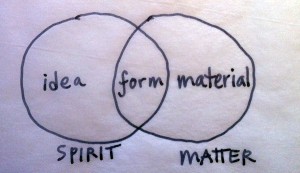“Seek the real practical life,
but seek it in a way that does not blind you
to the Spirit working in it.
“Seek the Spirit, but do not seek it
in Spiritual greed, from Spiritual egoism,
but look for it because you want to apply it unselfishly
in practical life in the material world.
“Make use of the ancient principle:
Spirit is never without matter, matter never without Spirit.”Rudolf Steiner, 9.24.19
Recently, I had occasion to consider what matters most to me as an architect, and this was my answer: I like to play with the balance of spirit and matter. The Steiner verse above has been my guiding light for the past three years or so, helping me to navigate our overly materialistic culture so it doesn’t drive me absolutely crazy. By “materialistic,” I don’t mean only that we Americans buy and have a lot of stuff and spend more time shopping than reading with our kids. I also mean that our dominant cultural story is that something is only “real” if it can be measured, scientifically described, and known by the rational mind.
I have come to accept that one of my roles – and this is not easy to admit – is to challenge that assumption and to put forth my own version of the reintegration of spirit and matter. So far, I’ve worked with this as an architect and professor. Lately, I’m also exploring other media, including writing essays and fiction and offering Restorying workshops.
In my architecture master’s thesis, I identified three aspects or stages of designing a building: idea, form, and material. In the diagram below, idea belongs in the “spirit” circle and materials (wood, brick, stone, metal) in the “matter” circle. In the overlap is “form,” which refers to all aspects of the shape of the building, including orientation, windows, heights of rooms, roofline.
Idea is not bound by time or budget because spirit is free: it is everywhere. Form is partly bound by time and budget. A little forethought will give you the window that frames a view to the garden or lets in the sunrise. That’s what I get paid to think about. Builders are necessarily focused on material – and thank god for that. They also have input on form, because being human they too have insight and ideas.
To get a delightful result, my role is to balance out spirit. If we focus only on matter, the resulting building tends to be rather soulless. We can all recognize it when we are in a good place. It is beautiful and uplifting and moving. It makes us smile, dance, sing. As Mrs. Leighey, who lived in Frank Lloyd Wright’s Pope-Leighey house in northern Virginia, said to my friend during a tour: “Living here has made me a better person.”
I always ask my clients what they want for their project. If anything poetic or cryptic is part of the answer, that’s a good sign I can be helpful. Even if it’s not overt, if it’s just a feeling or a collection of photographs, I know what questions to ask to tease out the vision and court delightful solutions.
Designing a building, whether a new church or a house remodel, depends on the participation and trust of everyone involved. It’s an iterative process, which sometimes feels like one step forward and two steps back. There is ambiguity and paradox – which is always a good sign, because it means that Spirit is in the room.
Since we all live in the real world of schedules and budgets, it’s helpful to remember that budget and delight are NOT mutually exclusive. It’s all in the intention and the forethought.




Leave a Reply